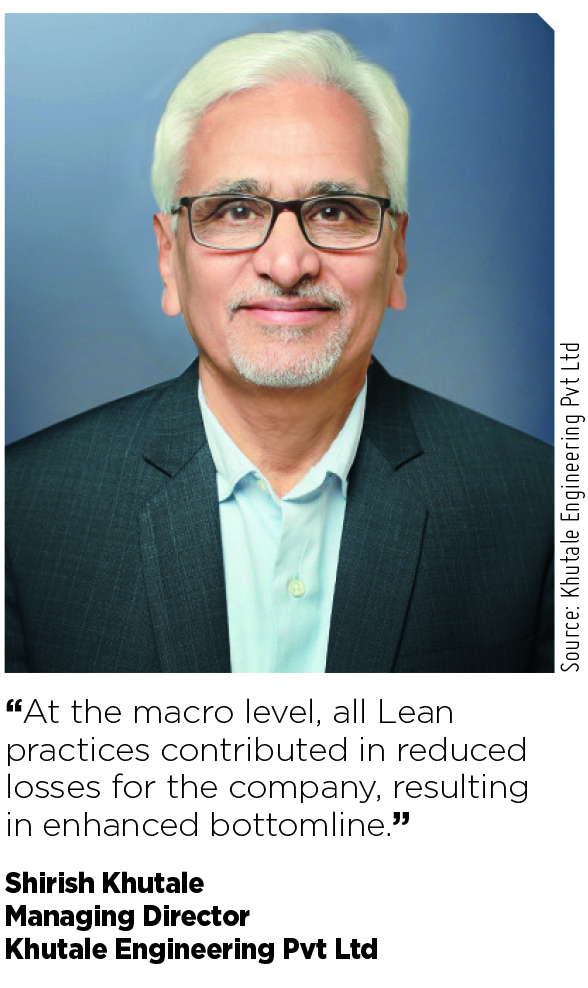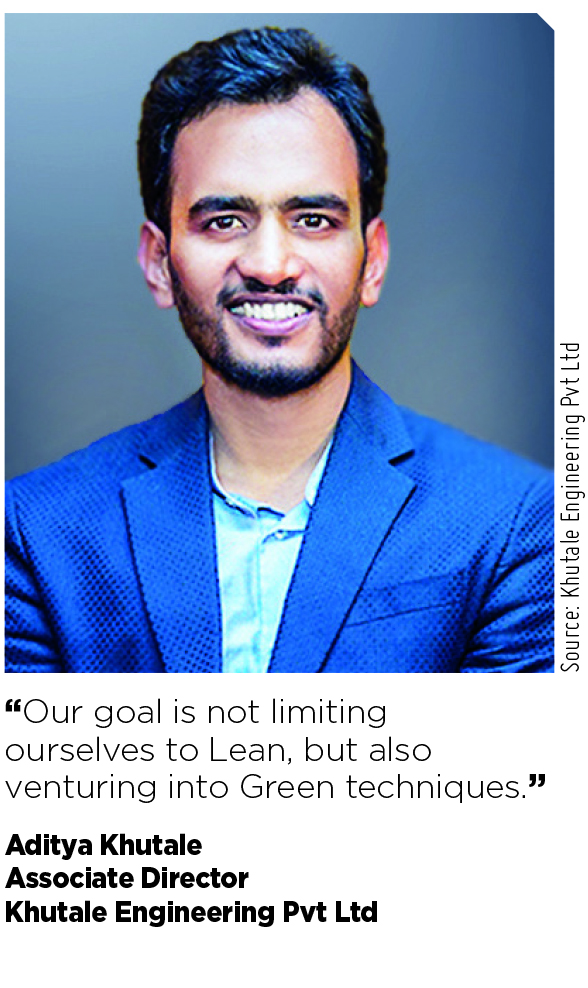Integrating Lean and Green

With the aim to achieve manufacturing excellence in its processes and become a world-class manufacturing unit, Khutale Engineering successfully dealt with numerous challenges in its path towards growth with the Lean and Green approach.
After having gained 15 years of experience in the automobile industry, Shirish Khutale, Managing Director, Khutale Engineering Pvt Ltd (KEPL), found himself ready to take the plunge into the manufacturing industry. What started as a humble powder coating set-up in 1989, is today a world-class manufacturing unit spread over 30,000 sq ft, providing employment to 140 individuals. Located in Satara, Maharashtra, these units are QMS, EMS and among the first GreenCo Platinum Rated SME units of the country.
A key vendor to Godrej & Boyce Mfg. Co. Ltd’s three divisions: Appliances, Interio and Prima since 1996, KEPL is into sheet metal pressed, formed, tubular fabricated components and assemblies for white goods, furniture, auto and other engineering industries.
KEPL is the first company to acquire GreenCo Platinum rating in the MSME category throughout the country and it is proud to have Green Vision and Green Purchase Policy.
Taking the Lean Way
While Khutale’s vision was rooted in building a competitive, efficient and quality-driven enterprise with the customer at its core, the alignment came with the introduction of white goods Lean manufacturing cluster activities in 2010 that helped employees at every level understand the importance of Lean Manufacturing Practices. Additionally, a visit to Japan as a member of international study mission, CII-MSME delegation in 2014, convinced Khutale that Lean is the only way forward. “These activities eventually formed the very DNA of our day to day routine and resulted in safe working environments, clean shop floors, inventory control, well-managed raw material, organized man-material movement, low-cost automation, segregated scraps, better inter-department communication, improved documentation, reduced breakdowns and increased employee participation,” shares Khutale.


Towards Boosting Productivity
At KEPL, the thrust has always been upon continuous improvement in production practices. Its meticulous research and kaizen-based approach helped the company in zeroing down on a much-needed layout change for the shop floor in order to increase efficiency. The following case study elaborates the ways in which resources can be managed well while simultaneously increasing the productivity of the fabrication line by reducing material transportation time, waiting time and operator movement.
Of the three production lines and one finishing line i.e. Powder coating line, the latter needed immediate attention since it was lagging behind in all parameters in comparison with other lines. Primary contributors to poor productivity were: scattered layout, extreme throughput time, unnecessary inventory, improper utilization of space and long waiting time. The working conditions were poor and unsafe besides the high Muda (waste), Muri (overburden) and Mura (unevenness). Unorganized material storage also posed a threat to movement.
Also, due to long distance movement, the material was getting damaged while in transit. Of the total time, 79 percent would get consumed in material handling, wasting the potential of the labor.
Before implementing any major change in the organization, especially those related to the layout, Khutale faced a few challenges. The first one was capital investment in refurbishing the civil structure. Second issue was the production loss during the implementation phase. Lastly, it was a difficult task to change the mindset of employees to adapt to the transformation.
To address these, internal teams were formed, and roles and responsibilities were assigned towards data collection, analysis, implementation and validation.
Role of Industrial Engineering in Layout Conceptualization
PQ Analysis : PQ Analysis helped the company in finding Runners, Repeaters and Strangers which benefited in redesigning the layout. Due to the size and the scale of Runner and Repeater items, it was imperative to change the layout. With the help of Flow Chart, String Diagram of existing layout was made, which indicated paths or movements of man and material, back tracking, congestion, bottlenecks, and over and underutilized paths on the shop floor.
REL Chart : With the help of REL Chart, Qualitative Closeness between departments was determined. Rating was assigned by the KEPL team on the basis of various factors like flow of material, need for supervision, use of some equipment, high noise levels and chances of contamination. The concept of ‘Everything on wheels, Nothing on the shop floor’ was implemented, which made the team put all the items on wheeled crates, trolleys and pallets.
Flow Process Chart : The chart helped them record each activity within the process involved in making the product along with its cycle time and distance traveled. One of the bottleneck operations was bending and welding. In order to overcome these, enhancing facility and redesigning the layout were two major priorities on the agenda.
The old layout was scattered, and high material movement resulted in poor quality and underutilization of workers The distance travelled by the product was 247.5m; daily trips between RM store to Pipe Cutting M/C were four to six and the distance between the same was 45m i.e. 5.9 Km/month.
Activity Relationship Diagram : For MSMEs like KEPL, Khutale asserts that space is a prime concern and constraint. The diagram derived from REL Chart helped in determining the necessity of closeness between certain departments. At the same time, the available and required space for each department was also determined.
Space Relationship Diagram : The diagram was derived from Activity Relationship Diagram. Each department was drawn to scale. After analysis, four proposals were made out of which the best was selected. All stakeholders from department heads to their subordinates were aligned and trained. Machines were shifted to suit the new layout under safe and secure conditions. Manpower was trained to the new layout change. For the layout to function to its full capacity, addition of machines and manpower was done wherever necessary. For better safety and alertness, implementation of ‘working in the standing position’ was done across the shop floor.

Benefits Abound
Chaitanya Rasane, Industrial Engineer, KEPL, adds that productivity has been improved by 20 percent, inventory decreased to max two days, floor space utilization increased by `29,480, throughput time improved by two days resulting in improved DSA by 11 percent. Productivity has gone up to 80 percent from the earlier 60 percent. Additionally, a manpower of five individuals has been saved. Other benefits through layout implementation are added space availability for productive use, gangways throughout the shop floor and jogging track of 1m width along the periphery wall of the company.
Holistic Development through Lean activities
Other than layout imple-mentation, other important facets of LEAN cluster activities have been data collection, documentation, monitoring and analysis of key performance indicators related to P-Production, Q-Quality, C-Cost, D-Delivery, S-Safety, M-Morale and E-Environment termed as PQCDSME. A culture of identification and elimination of MUDA in every process has been created by encouraging suggestions and participation from various levels of hierarchy within the company. There is an increase in the use of Personal Protective Equipment (PPE) wherever required and awareness of safe working conditions. This has led to rise in the number of employees taking ownership and handling tasks end to end, resulting in efficient and smooth working of the system.
 Merging Green and Lean Strategies
Merging Green and Lean Strategies
Khutale shares that exposure to Greenco rating has led to the realization that there are not just seven types of wastes but an eighth waste too, which is a collective waste of resources such as gas, electricity, water and raw material. This waste is often ignored by entrepreneurs in their competitive pursuits but has a lasting impact on productivity in the long run.
Learnings in Green manufacturing and GHG study has helped KEPL in reducing carbon emissions. In this pursuit, the company has installed VFD and replaced the conventional reciprocating compressors with energy efficient screw compressors. This has resulted in more flexible and efficient movement and also saved on the cost of shearing. All GI C class air lines have been replaced with aluminum airlines, and IE 2 class Elect Motors have been replaced with IE 3 class. Rooftop PV Solar Renewable Energy System of 40KW has also been installed.
According to Khutale, customers like Godrej and association with CII has been of immense help in transforming KEPL into Lean, Green and ZED (Zero Defect, Zero Effect) in its journey towards becoming a world-class manufacturing unit.
Layout implementation has improved production per shift by 20%. Productivity has gone up from 60% to 80%, and production of sub components per shift has improved by 78%.




 Facebook
Facebook.png) Twitter
Twitter Linkedin
Linkedin Subscribe
Subscribe